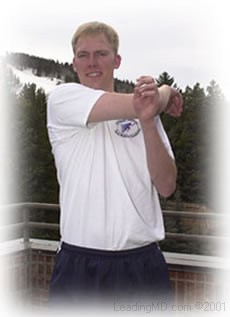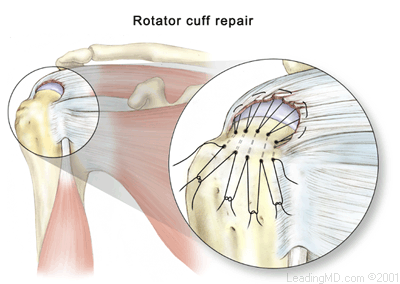OVERVIEW
Shoulder injuries are common in both young, athletic people and the aging population. In each of these age groups, there are numerous causes of shoulder pain. Two of the most common problems occur in the narrow space between the bones of the shoulder. Irritation in this area may lead to a pinching condition called impingement syndrome, or damage to the tendons known as a rotator cuff tear. These two problems can exist separately or together. It is likely that rotator cuff tears are the result of impingement syndrome and age related changes within the rotator cuff tendons.
The shoulder is the most mobile joint in the human body, with a complex arrangement of structures working together to provide the movement necessary for daily life. Unfortunately, this great mobility comes at the expense of stability. Several bones and a network of soft tissue structures (ligaments, tendons, and muscles), work together to produce shoulder movement. They interact to keep the joint in place while it moves through extreme ranges of motion. Each of these structures makes an important contribution to shoulder movement and stability. Certain work or sports activities can put great demands upon the shoulder, and injury can occur when the limits of movement are exceeded and/or the individual structures are overloaded.
What is impingement syndrome?
Shoulder impingement syndrome occurs when the tendons of the rotator cuff and the subacromial bursa are pinched in the narrow space beneath the acromion. This causes the tendons and bursa to become inflamed and swollen. This pinching is worse when the arm is raised away from the side of the body. Impingement may develop over time as a result of a minor injury, or as a result of repetitive motions that lead to inflammation in the bursa.
Particular shapes of the acromion may make certain individuals more susceptible to impingement problems between the acromion and the bursa. With age and the onset of arthritis, the acromion may develop bone spurs that further narrow this space. Impingement caused by bone spurs on the acromion is common in older patients who participate in sports or work activities that require overhead positions. Spurs may also result if one of the ligaments in the coracoacromial arch becomes calcified.
Impingement is classified in three grades:
-
Grade I is marked by inflammation of the bursa and tendons
-
Grade II has progressive thickening and scarring of the bursa
-
Grade III occurs when rotator cuff degeneration and tears are evident
What is a rotator cuff tear?
Continual irritation to the bursa and rotator cuff tendons can lead to deterioration and tearing of the rotator cuff tendons. The tendon of the supraspinatus muscle is the most commonly involved tendon among the rotator cuff muscles. This muscle forms the top of the cuff and lies in the narrow space beneath the acromion. It is subject to the most pinching of all the rotator cuff muscles.
Rotator cuff tears can be the result of a traumatic injury or deterioration over time. Symptoms may be present, but in many cases, the patient experiences no symptoms at all. In young active people, full thickness rotator cuff tears are fairly uncommon. When they do occur, they are usually the result of a high-energy injury to the rotator cuff that is associated with throwing or overhead sporting activities. In older people, rotator cuff tears tend to be the result of wear and tear over time. Several scientific studies have shown that up to 2/3 of the population at age 70 have rotator cuff tears; many of these people had no symptoms.
What are the signs and symptoms of impingement syndrome?
Most often the onset of symptoms is related to an episode of overuse. In many patients, the episode occurred some time in the past and the shoulder has failed to return to normal.
Impingement symptoms are marked by pain:
The pain is sharp and intermittent in its early stages. As impingement progresses, the pain becomes more of a constant ache.
What are the signs and symptoms of a rotator cuff tear?
The symptoms of a rotator cuff tear are very similar to those of impingement syndrome with the added complaint of weakness. This weakness will vary depending on which rotator cuff tendon has been torn. For example, if the supraspinatus muscle is involved (as is most often the case) weakness will be present with forward arm elevation and overhead activity. Many patients are at first unaware of how much strength they have lost when they tear the rotator cuff
Although pain is usually present after impingement sets in, the original event that led to the problem is often relatively minor and not remembered as painful. Once inflammation starts, simple movements may become painful.
Overhead motions tend to increase the pain. There is less space for the bursa when the arm in this position, causing more compression on the bursa.
Arm movements at waist level are not painful. In this position, there is more space for the bursa, and therefore it is less compressed.
Pain usually increases at night for two reasons. First, inflammation and swelling tend to get worse as the shoulder is used during the day, and this can lead to more pain in the evening. Second, the mind is usually less occupied in the evening, allowing pain to become a major focus of attention.
How are impingement and rotator cuff tears diagnosed?
With a careful history and physical examination, impingement and rotator cuff tears can be easily diagnosed in the doctor's office. Further testing may be necessary to determine the exact nature of a rotator cuff tear.
After the evaluation of symptoms, the doctor will perform certain muscle tests to determine whether there are tears in the rotator cuff tendons and to rule out other conditions. The doctor may place the arm in positions that reproduce the described pain to confirm the diagnosis.
There are many tests that can isolate specific areas of pain and weakness to help make the diagnosis. Further evaluation may include:
- A diagnostic injection can help the doctor distinguish between impingement syndrome and a full thickness rotator cuff tear. A local anesthetic is injected into the inflamed bursae to eliminate the pain. If strength in the shoulder returns once the pain is blocked, it is likely that the weakness was due to pain and the rotator cuff tendons are not torn. A rotator cuff tear is suspected if strength does not return while the pain is blocked.
-
X-rays can reveal signs of arthritis, fractures, and bone spurs on the acromion. They can also reveal changes in position of the humerus and scapula that may suggest a rotator cuff tear. These images are frequently negative in the early stages of injury since X-rays show bone structure but not soft tissue.
-
An MRI (Magnetic Resonance Image) allows the physician to see muscle and other soft tissue not visible with X-ray.
-
An arthrogram is another method used to help diagnose a rotator cuff tear. A dye is injected into the shoulder and X-rays are made. If a tear in the rotator cuff tendons exists, the dye will run through the tear and make it visible on X-ray.
-
Ultrasound may also be used to diagnose a tear; however, results with this technology are difficult to evaluate and are very dependent on the skills of the technician and radiologist.
How are impingement and rotator cuff tears treated?
Impingement and rotator cuff tears can be treated non-operatively or with surgery.
Treatment for both injuries usually begins with a non-operative treatment plan. More than 2/3 of impingement patients can expect significant improvement in their symptoms with a physical therapy program alone. These results are lower in older patients and in those with large bone spurs.
When trauma causes a tear in younger patients, surgery is often the first choice of treatment. Patients with this type of injury recover best if surgery is done early. Generally, this pertains to those patients under the age of fifty with tears less than four weeks old.
Non-Operative Treatment
Non-operative treatment is similar for both impingement and rotator cuff tears. A vast majority of patients improve with this primary treatment alone. The goals of a physical therapy program include:
- strengthening the rotator cuff tendons.
- stretching and regaining lost motion caused by pain and inflammation.
- allowing the humerus to be better positioned under the acromion, thus reducing compression of the bursa.
Anti-inflammatory medication may be prescribed to help reduce pain and inflammation. Many patients with rotator cuff tears can function quite well if pain and inflammation are controlled with medication and physical therapy. This is especially true for the elderly and those with low demands on the shoulder.
If symptoms have not improved with this program, the doctor may recommend a steroid injection into the bursa. Cortisone, or a similar steroid, is often combined with a local anesthetic to help control the pain and inflammation of the bursa. Steroid injections are used with caution. Damage to the rotator cuff tendons may occur with more than two or three injections over several months. Patients with diabetes are generally not good candidates for steroid injections because of problems with glucose control.
Operative Treatment
Impingement
A non-operative treatment plan is often all that is necessary for most patients with impingement syndrome. However, the small percentage of patients whose symptoms have not improved after 6 months of dedicated physical therapy may be candidates for surgery. The shoulder should be reevaluated to make sure no other problems exist.
Subacromial decompression expands the space between the acromion and rotator cuff tendons. This can be done either arthroscopically or with open incisions, depending on the preference of the surgeon. During an arthroscopy, a tiny fiberoptic instrument is inserted into the joint. In many cases, the doctor can assess and repair the damage through this scope without making large incisions. Scar tissue or bone spurs can successfully be removed with either technique. If a rotator cuff tear is found at the time of surgery, it can also be repaired if necessary.
Rotator cuff tear
Not all rotator cuff tears require surgery. Many patients are content with their progress following a non-operative treatment plan. Patients who have been unable to regain lost motion and strengthen the surrounding muscles sufficiently may need a rotator cuff repair. This is often the case for the younger, more active patients who want to address continued weakness following physical therapy.
|
||||
Rotator cuff repairs can be performed either arthroscopically or with open incisions. Arthroscopic techniques are new and limited to specific types of tears. An open repair that secures the rotator cuff tendons back to the humerus remains the surgical treatment of choice.
What types of complications may occur?
Complication rates after surgery are generally low. Pre-operative antibiotics are given to reduce the slight risk of infection after surgery. Infection tends to occur a little less often when arthroscopic techniques are used. Risks of major bleeding or nerve damage are extremely small. Postoperative stiffness is the major complication of both impingement and rotator cuff tears.
Post-surgical care for impingement and rotator cuff tears are similar. General care recommendations include:
- Incisions must be kept dry for two or three days after surgery.
- Stitches are usually removed 7 - 10 days after surgery.
Rehabilitation programs for impingement and rotators cuff surgery differ slightly.
Impingement rehabilitation begins almost immediately:
- Exercises to regain shoulder motion usually begin with a therapist in the first week after surgery and continue for about 6 weeks.
- At 6 weeks, most patients have regained full motion and will continue to regain strength with a home exercise program.
- Full recovery time after surgery varies; most patients have greatly improved at 3 months and are close to normal by 6 months.
Rotator cuff recovery is generally slower and requires more supervision. In order to achieve a full and rapid recovery, surgery should be performed as soon as the patient has full range of motion and has gained good muscle strength from a physical therapy program started when the injury is first detected. After surgery, the patient follows a closely monitored program:
- Therapy is carefully controlled in the first 6 - 12 weeks while the tendons heal back to the bone.
- The first goal is to regain full motion within 3 months after surgery. A therapist will assist in the early stages with gradual recovery of motion.
- During the first 6 weeks, there is no active use of the shoulder in order to protect the surgical repair.
- Once initial healing is achieved, a progressive stretching and strengthening program should begin.
- Full recovery can take more than 6 months. Some patients may require more time to regain muscle strength and complete the healing process
Rotator Cuff / Impingement >> FAQs
Will a torn rotator cuff require surgery? This answer to this question depends on the condition of the other shoulder muscles and the age of the patient. Many older patients have no symptoms with a rotator cuff tear and continue to function without pain or disability. In one study, up to 40% of patients over the age of 70 had no symptoms with a tear of the rotator cuff tendons. The goal of physical therapy is to maximize the function of the remaining tendons, and hopefully avoid surgery. In the younger age groups, particularly when tears are caused by a sudden injury, early surgery is generally recommended to insure a successful treatment outcome. What is physical therapy likely to do to make mechanical impingement better? Physical therapy is the mainstay of treatment for impingement. The vast majority of patients improve with therapy and oral anti-inflammatory medication. Strong rotator cuff muscles can relieve impingement symptoms by exerting a downward force on the humeral head, opening up the space available under the acromion. Spurs that develop beneath the acromion cannot be resolved with physical therapy, but the healthier the rotator cuff is, the less likely it is that surgery will be required. Are there harmful effects of steroid injections for impingement? Generally speaking, a limited number (3-5) of steroid injections into the bursa are a safe, and often effective way to locally reduce inflammation and alleviate pain. These locally applied steroids do not have the same risks associated with the chronic use of oral steroids since the body does not systemically absorb them. However, it has been shown that repeated steroid injections can damage the quality of the rotator cuff tendons if a repair is later required. References |


